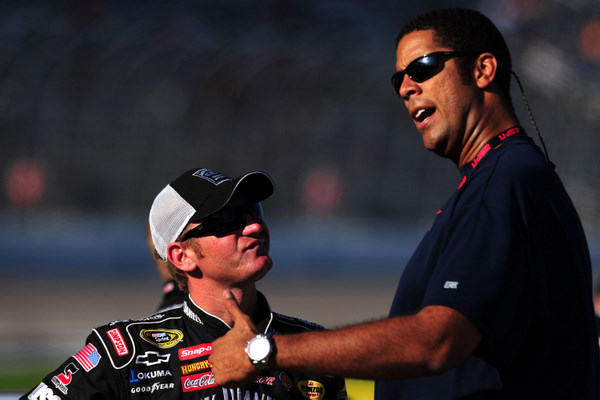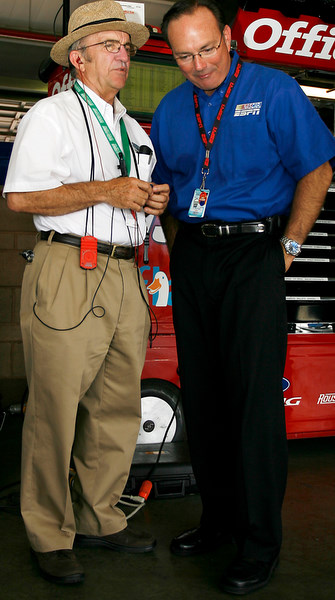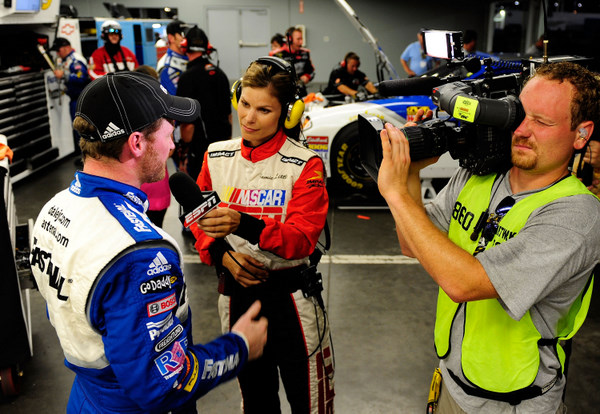ESPN studies sports demographics, and finds some interesting results
ESPN's Shannon Spake, interviewing Denny Hamlin (Photo: Getty Images for NASCAR)
By Mike Mulhern
mikemulhern.net
Curious, curious: An ESPN study of sports demographics, just released Friday by the network, shows dramatically different "sports consumption," depending on age and sex.
The research report basically considered the U.S. sports fan group of some 219 million aged 12-and-up.
Glenn Enoch, who handles media research for the company, provided the study, which could obviously help in sports marketing and promotion.
"We have done research on sports fans and sports consumption, but now we have put all the pieces together, to show how people evolve as sports fans through their lives, and how adult sports fans interact with children to start a new cycle," Enoch says.
The study just released provides a lot of generalities, some obvious, some not so obvious, some even unexpected.
However the study didn't offer all appropriate demographic angles -- race, a major one (considering the major Hispanic push by NASCAR and by ESPN). And the study released didn't differentiate between different parts of the country -- for example, how likely are Hispanic women 35-and-older in Southern California to watch sports events, versus Hispanic males in that demographic.
The ESPN results, though, do show some interesting patterns, though more specific studies could well be done in particularly important markets like Los Angeles, Chicago, New York-Philadelphia, Boston, the Midwest, and Miami.

ESPN's Brad Daugherty towers over Clint Bowyer (Photo: Getty Images for NASCAR)
The results released showed:
-- Boys start out watching sports with an adult, and most of their TV viewing is done with other.
-- Teeenage boys are the most avid about sports, apparently because of their active participation. Enoch pointed to sports as "social currency." However Enoch says this group still doesn't spend a lot of time watching sports events on TV, preferring sports summary programs to stay up to date.
-- College-age men are major sports TV consumers, watching more than three hours of national sports TV each week. And this group is more likely to be viewing the events alone, rather than in a group. This demographic, ESPN says, is a major consumer of sports magazines.
-- Males 25-34 increase their TV consumption of sports events (which ESPN discusses separately from what it terms 'information viewing).' This group, Enoch says, spends about 20 percent of 'sports media time' on other things beside actual television. ESPN, NASCAR, Fox and all the various NASCAR-sports internet outlets are following this part of the story very closely of course. In more detail here: This demographic is strongly into internet video, spending some 25 percent of their internet sports viewing here.
-- Among males 25-49 (with family and careers to consider), sports 'avidity' and sports-news TV viewing declines, ESPN says. However this demographic shows the highest percentage of internet sports consumption. And this group picks up sports event viewing with the kids...starting another 'cycle.'
-- Males 50-and-over likewise have 'lower sports avidity,' as ESPN describes it. However this group watches over four hours a week of sports, more than the other groups, watching events themselves rather than news wrap-up shows. College events are high here.
-- When the male 50-and-over demographic watches sports with others, it's usually with a woman. (ESPN says women 50-and-over constitute about 30 percent of its audience in this segment.)
-- Males 50-and-over spend less time on non-TV sports 'platforms.' This group instead looks more to radio.

ESPN's Jerry Punch listens to car owner Jack Roush (Photo: Getty Images for NASCAR)
-- Young girls likewise don't spend much time watching TV sports, and when they do, it's typically with an adult.
-- Teenage girls don't watch much sports TV either, but they are major sports fans, apparently because of their own sports activities.
-- For females age 18 is a demarcation line, with sports activities and 'avidity' falling sharply.
-- Women 25-34 are the group least interested in sports.
-- Women 35-and-older, however, pick back up in sports interest, usually viewing with others, men or their families.
-- Curiously perhaps, women 50-and-over become bigger sports fans, and their viewing interests increases at a rate much faster than men in this group, ESPN says.
That's what Enoch found, and he says the results should not only help the network in its sports coverage "but will provide a rich picture of their life-stages to advertisers, to rights-holders and to our business partners."
The various aspects of 'consuming' sports is increasingly importantly for ESPN -- and of course NASCAR and NASCAR teams -- to understand, not only for sponsorship angles but also because ESPN employs wide array of sports media, including a number of U.S. TV networks (ESPN, ESPN2, ESPN Classic, ESPNEWS, ESPN Deportes, and ESPNU), regional TV, and an international arm, ESPN radio, a magazine, an internet site, and sports-themed restaurants.

ESPN's Jamie Little, in the NASCAR garage, with Dale Earnhardt Jr. (Photo: Getty Images for NASCAR)
© 2010-2011 www.mikemulhern.net All rights reserved.
Web site by www.webdesigncarolinas.com







Doesn't sound like the Evil
Doesn't sound like the Evil Empire bothered to disclose how various groups view it.
Ouch! Let me ask them for
Ouch!
Let me ask them for you....
So Mike, what is your take on
So Mike, what is your take on what this study means?
i really want some more
i really want some more details, and i'm sure espn/abc has it, market by market, race/gender/yada....but generally it looks like we've got three distinct audiences we're playing to, and i'm not sure how to appeal to all three. the classic nascar audience is a bit older, 35-59, i guess, someething like that, where women become a major factor; the 24-35 group is more problematic....not sure what that demographic is looking for, or how we can deliver -- though i really think this is where -- don't scream at me -- danica could help. and then the under-24 group, which is probably pretty wishy-washy at best, but where joey logano could help....and maybe brian vickers.....i really want to see a market by market breakout.....america is not monolithic....we need to see where we need to hit what demo.....like southern california and miami-homestead and kansas-iowa-midwest are obviously different from talladega/daytona.....each market has a different dynamic. i need to do more research.
Good
Good
Post new comment